
Desha County is a county located in the southeast part of the U.S. state of Arkansas, with its eastern border the Mississippi River. At the 2020 census, the population was 11,395. The county seat is Arkansas City.
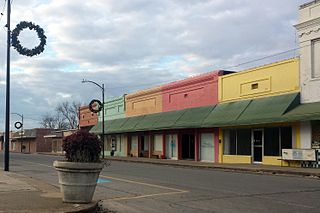
Lake Village is a city in and the county seat of Chicot County, Arkansas, United States. The population was 2,575 at the 2010 census. It is located in the Arkansas Delta. Lake Village is named for its location on Lake Chicot, an oxbow lake formed by the Mississippi River.

Arkansas City is a town in Desha County, Arkansas, United States. The population was 376 at the 2010 census. The town is the county seat of Desha County. Arkansas City Commercial District, located at Desoto Avenue and Sprague Street, is listed on the National Register of Historic Places.

McGeheemə-GHEE is a city in Desha County, Arkansas, United States. The population was 4,219 at the 2010 census.

Tillar is a town in Desha and Drew counties in the U.S. state of Arkansas. The population was 225 at the 2010 census. The area west of it was known as Tillar Station. Frank Tillar Memorial Methodist Episcopal Church, South is listed on the National Register of Historic Places.

Historic Washington State Park is a 101-acre (41 ha) Arkansas state park in Hempstead County, Arkansas in the United States. The museum village contains a collection of pioneer artifacts from the town of Washington, Arkansas, which is a former pioneer settlement along the Southwest Trail. Walking interpretive tours are available throughout the 54 buildings. Washington served as a major trading point along the Southwest Trail, evolving into the Hempstead county seat and later the capital of Arkansas from 1863 to 1865 when Little Rock was threatened during the Civil War. The original plat of Washington was added to the National Register of Historic Places in 1972 as the Washington Historic District.
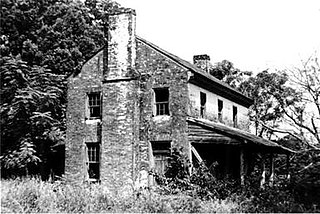
The McGehee–Stringfellow House, also known as Oak Grove, was a historic plantation house near Greensboro, Alabama, United States. It was added to the National Register of Historic Places on September 17, 1980, due to its architectural significance. It was accidentally destroyed in the 1980s during an attempt to move it to another location.

Highway 1 is a north–south state highway in east Arkansas. The route of 159.88 miles (257.30 km) runs from US Route 278 (US 278) in McGehee north to Supplemental Route BB at the Missouri state line. One of the original 1926 state highways, Highway 1 has remained very close to its original routing. The highway contains an overlap of approximately 50 miles (80 km) with U.S. Route 49.
Sharpe House may refer to:
Hope Hull, also known as McGehee's Switch, is an unincorporated community in Montgomery County, Alabama, United States, southwest of Montgomery.

The Arkansas City High School was a comprehensive public high school serving students between 1910 and 2004 in Arkansas City, Arkansas, United States. Since 2005, the original 1910 building, which is listed on the National Register of Historic Places, has served as an annex of the neighboring Desha County Courthouse. It was a part of the Arkansas City School District.

Holly Grove Cemetery is a historic cemetery, located on the south side of Crooked Bayou Drive, 3 miles (4.8 km) southeast of McGehee, Arkansas. The cemetery is the only surviving remnant of the community of Trippe Junction, established in 1857 by the families of William Fletcher Trippe and his brother-in-law Benjamin McGehee. A railroad spur line was constructed to the area in 1877, and a small town grew up around it. By the 1920s all of its businesses had failed, and by 1930 all but one building had succumbed to fire. The Holly Grove Methodist Church adjoined the cemetery, and was the site of many funeral services. The church was serving as a school when it burned in 1913. In 1958, a group of citizens raised money to assist with maintenance and upkeep of the cemetery. A bicentennial marker was erected by the Desha Historical Society in 1974. The southern section of the cemetery was listed on the National Register of Historic Places in 1999.

Temple Meir Chayim is a historic former Reform Jewish congregation and synagogue, located at 4th and Holly Streets in McGehee, Arkansas, in the United States. The building operated as a synagogue between 1947 and 2016; and was listed on the National Register of Historic Places in 1999.

The Parnell-Sharpe House is a historic house at 302 North 2nd Street in McGehee, Arkansas. The 1+1⁄2-story brick house was built in 1936, and is probably unique in Desha County as an example of French Eclectic architecture constructed using local materials. The house is built out of red tapestry brick, and has a roughly T-shaped plan, with a projecting element in the front (west) facade that includes a tower topped by a conical roof. To the north is a single-story section that was originally a garage, but has been converted to interior space.
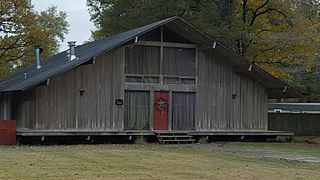
The Jay Lewis House is a historic house at 12 Fairview Drive in McGehee, Arkansas. The two story wood-frame house was built in 1955 to a design by Edward Durell Stone, an Arkansas native and a leading proponent of new formalism. It is the only Stone-designed house in Desha County, and one of only five in the state. The exterior of the house is clad in vertical cypress boards, with a porch that wraps completely around the house, and a breezeway connecting to a carport, built at the same time. The porch roof is supported by six Douglas fir beams. The interior of the house is based on Stone's modern reinterpretation of the traditional Arkansas dog trot form, with the central living/dining/kitchen area acting as the central element of that form. Other rooms of the house connect to this section, and are separated from it by Shōji screens. The house's basic design is similar to that of another house Stone designed in Englewood, New Jersey. The house is largely unchanged since its construction; one chimney has been replaced due to storm damage.

The McGehee National Guard Armory is a historic armory building at 1610 South First Street in McGehee, Arkansas. The armory, built in 1954, is a single story cinder block building faced in brick veneer. The metal gable roof is supported by a steel frame, with clerestory awning windows on either side. The large central area is surrounded on three sides by single story flat-roofed sections housing offices, kitchen space, and other support areas. The design of the building is typical of those produced by the Arkansas National Guard at that time. The building was used by the National Guard until 2005, and was given to the city the following year.
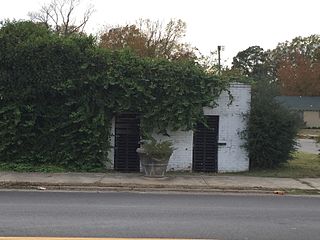
The former McGehee City Jail is a historic building at South First and Pine Streets in McGehee, Arkansas. The small, single-story brick building was built in 1908, and served as the city jail until 1935. The building's roof is made of concrete, and it has three cells, each with a separate outside door. All openings in the building are covered with heavy metal bars, and the doors are solid metal. Even though this building has sat vacant since 1935, it has survived the jail that was built to replace it.

The Missouri Pacific Railroad Depot-McGehee is a historic railroad station on Railroad Street in McGehee, Arkansas. The single-story brick building was built c. 1910 by the Missouri Pacific Railroad in its distinctive Mediterranean/Italianate style. The building is of particular importance in McGehee because the town is located where it is due to the company's decision to locate the station here. The station has a basic cruciform plan, an elongated rectangle with a projecting telegrapher's station on one side, and a matching projection on the other. It has a red tile roof, with a spreading cornice supported by Italianate brackets.
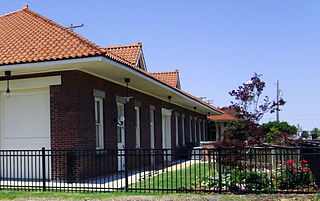
The Missouri Pacific Railway Van Noy Eating House is a historic restaurant building at the corner of Seamans Drive and Railroad Street in McGehee, Arkansas, US. The single-story brick building was constructed c. 1910 by the Missouri Pacific Railroad, and housed a dining establishment operated by the Van Noy Railway News and Hotel Company. It is one of a small number of such buildings to survive in the state. The building was divided into three parts: a central kitchen served a lunch counter area on one side and a dining room on the other. The establishment closed in 1948.

The Dr. E.P. McGehee Infirmary is a historic medical complex at 614 South Cokley Street in Lake Village, Arkansas. The complex began as a single wood-frame structure in 1910 serving as a medical clinic for the local African-American population. It was the town's primary infirmary from its establishment until 1973. It was established and operated by Dr. Edward Pelham McGehee until his death in 1950. It is now home to the Museum of Chicot County.




















